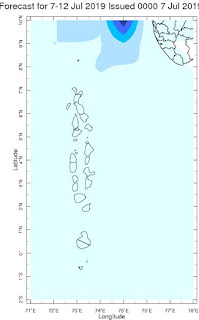‘Worrying’ rise in sea-levels in the Indian Ocean basin: Study
Sea-level reconstructions over the past two millennia
provide a pre-industrial context to assess whether the magnitude and rate of
modern sea-level change is unprecedented, the researchers said.
Toronto,
Dec 24, 2019, PTI: The sea levels in the central Indian Ocean have risen
by close to a meter in the last two centuries, according to a study. The
research, published in the journal Nature Geoscience, provides new details
about sea levels in the past.
Toronto,
Dec 24, 2019, PTI: The sea levels in the central Indian Ocean have risen
by close to a meter in the last two centuries, according to a study. The
research, published in the journal Nature Geoscience, provides new details
about sea levels in the past.
"We
know that certain types of fossil corals act as important recorders of past sea
levels" said Professor Paul Kench from Simon Fraser University in Canada.
"By
measuring the ages and the depths of these fossil corals, we are identifying
that there have been periods several hundred years ago that the sea level has
been much lower than we thought in parts of the Indian Ocean," Kench said.
Sea-level reconstructions over the past two millennia provide a pre-industrial context to assess whether the magnitude and rate of modern sea-level change is unprecedented, the researchers said. Understanding where sea levels have been historically, and what happens as they rise, will provide greater insights into how coral reef systems and islands may be able to respond to the changes in sea levels in the future, they said.
The ongoing study, which began in 2017, underscores the serious threat posed to coastal cities and communities in the region, the researchers said. It also suggests that if such acceleration continues over the next century, sea levels in the Indian Ocean will have risen to their highest level ever in recorded history, they said.
The study titled ‘Climate-forced sea-level lowstands in the Indian Ocean during the last two millennia,’ was conducted by Prof Kench, Roger F. McLean, Susan D. Owen, Emma Ryan, Kyle M Morgan, Lin Ke, Xianfeng Wang and Keven Roy.
The researchers in their abstract of the final report said: Sea-level reconstructions over the past two millennia provide a pre-industrial context to assess whether the magnitude and rate of modern sea-level change is unprecedented. Sea-level records from the Indian Ocean over the past 2,000 years are sparse, while records from the Atlantic and Pacific Oceans show variations less than 0.25 m and no significant negative excursions. Here, we present evidence of two low sea-level phases in the Maldives, Indian Ocean, based on fossil coral microatolls. Microatoll growth is constrained by low water levels and, consequently, they are robust recorders of past sea level. U–Th dating of the Maldivian corals identified lowstands at ad 234–605 and ad 1481–1807 when sea level fell to maximum depths of ?0.88 m and ?0.89 m respectively. These lowstands are synchronous with reductions in radiative forcing and sea surface temperature associated with the Late Antiquity Little Ice Age and the Little Ice Age. Our results provide high-fidelity observations of lower sea levels during these cool periods and show rates of change of up to 4.24 mm yr?1. Our data also confirm the acceleration of relative sea-level rise over the past two centuries and suggest that the current magnitude and rate of sea-level rise is not unprecedented.













